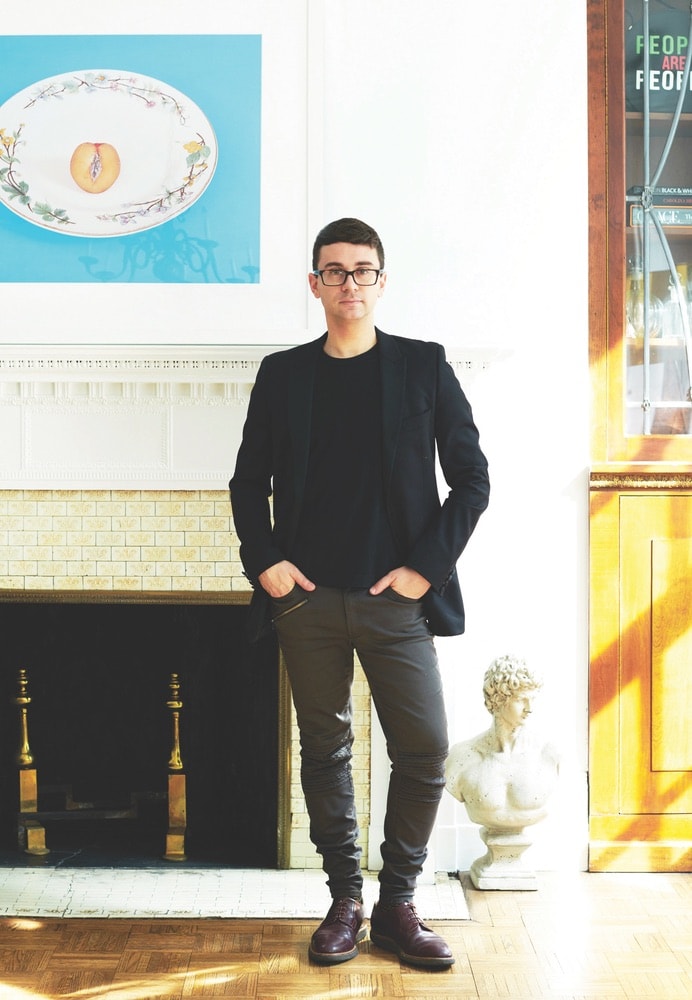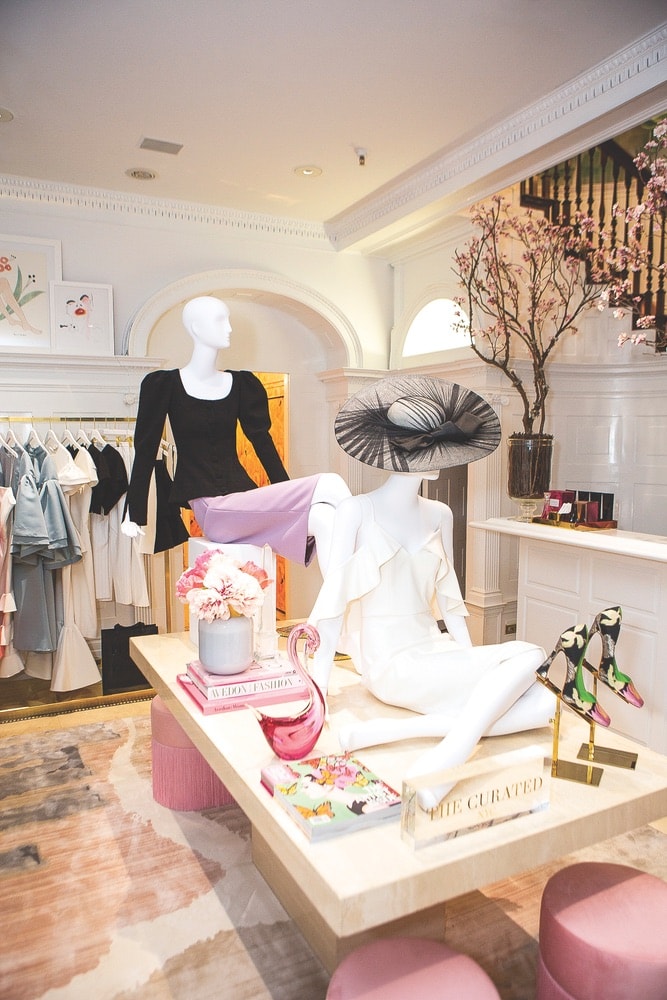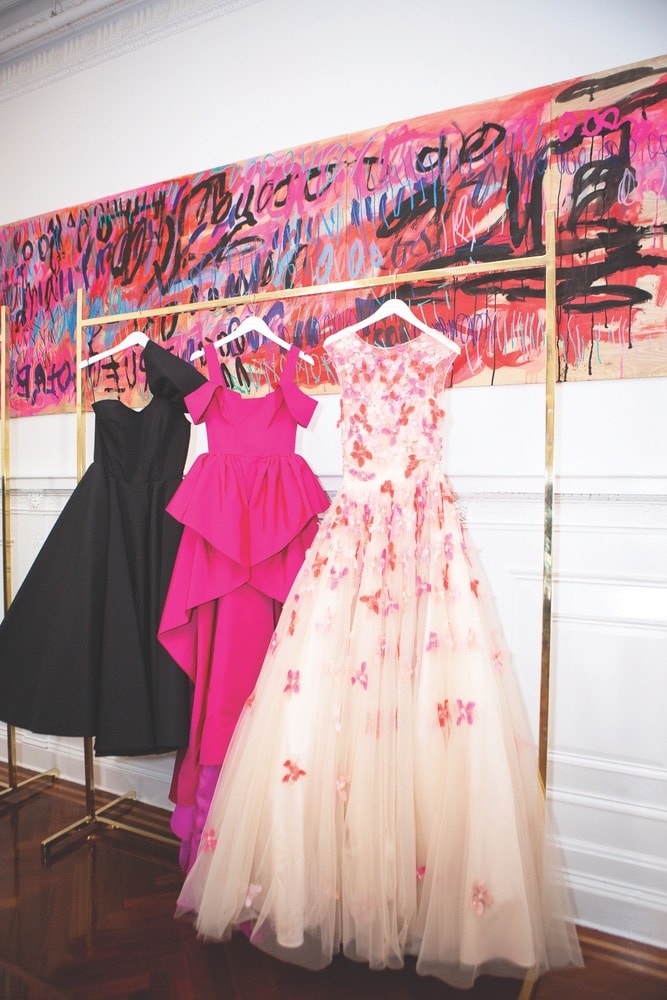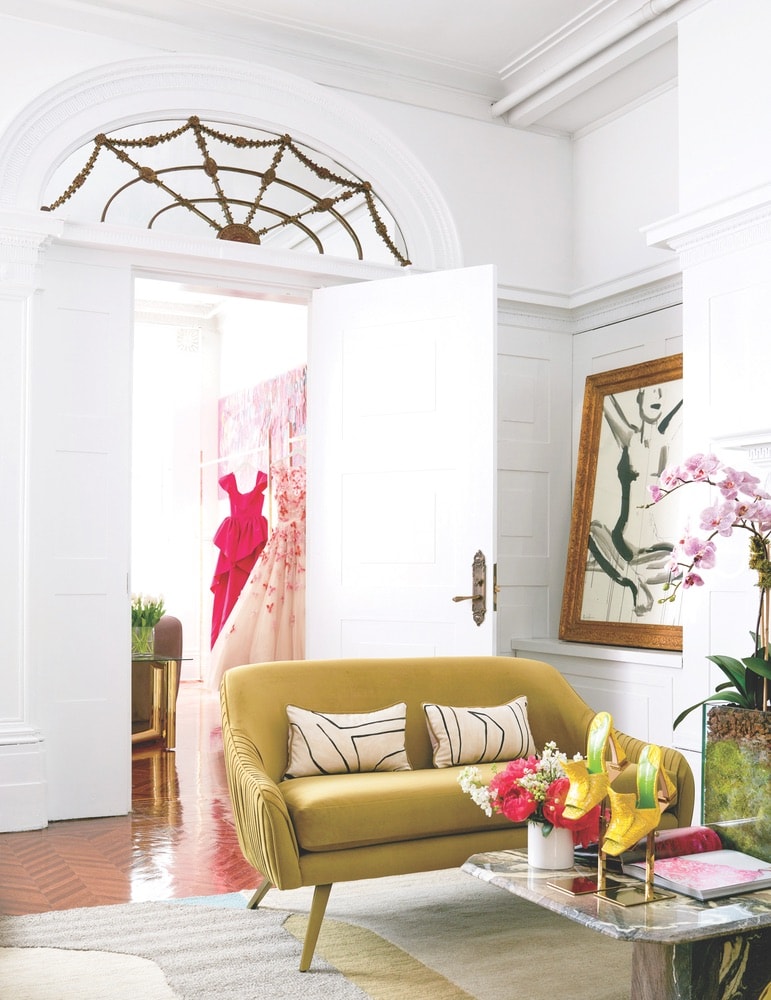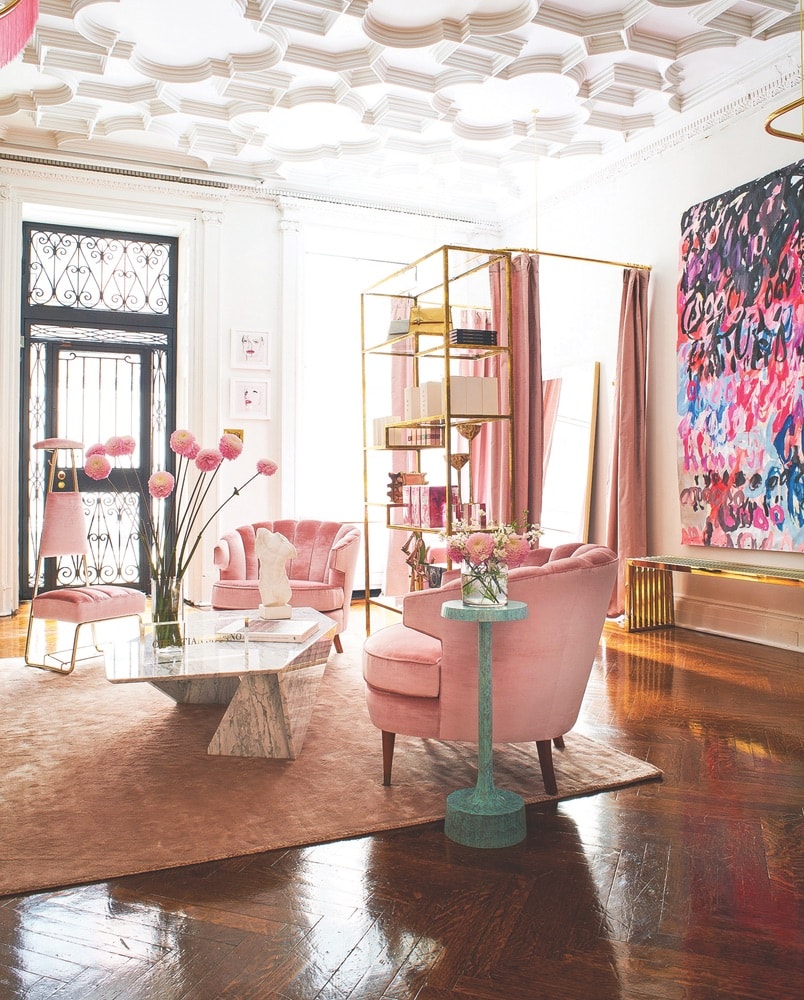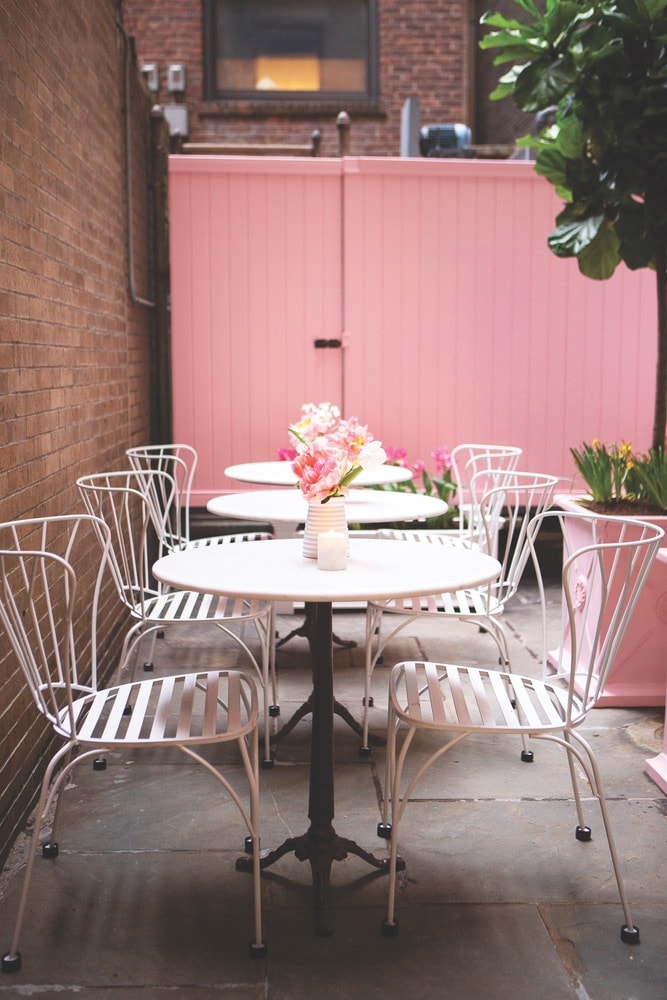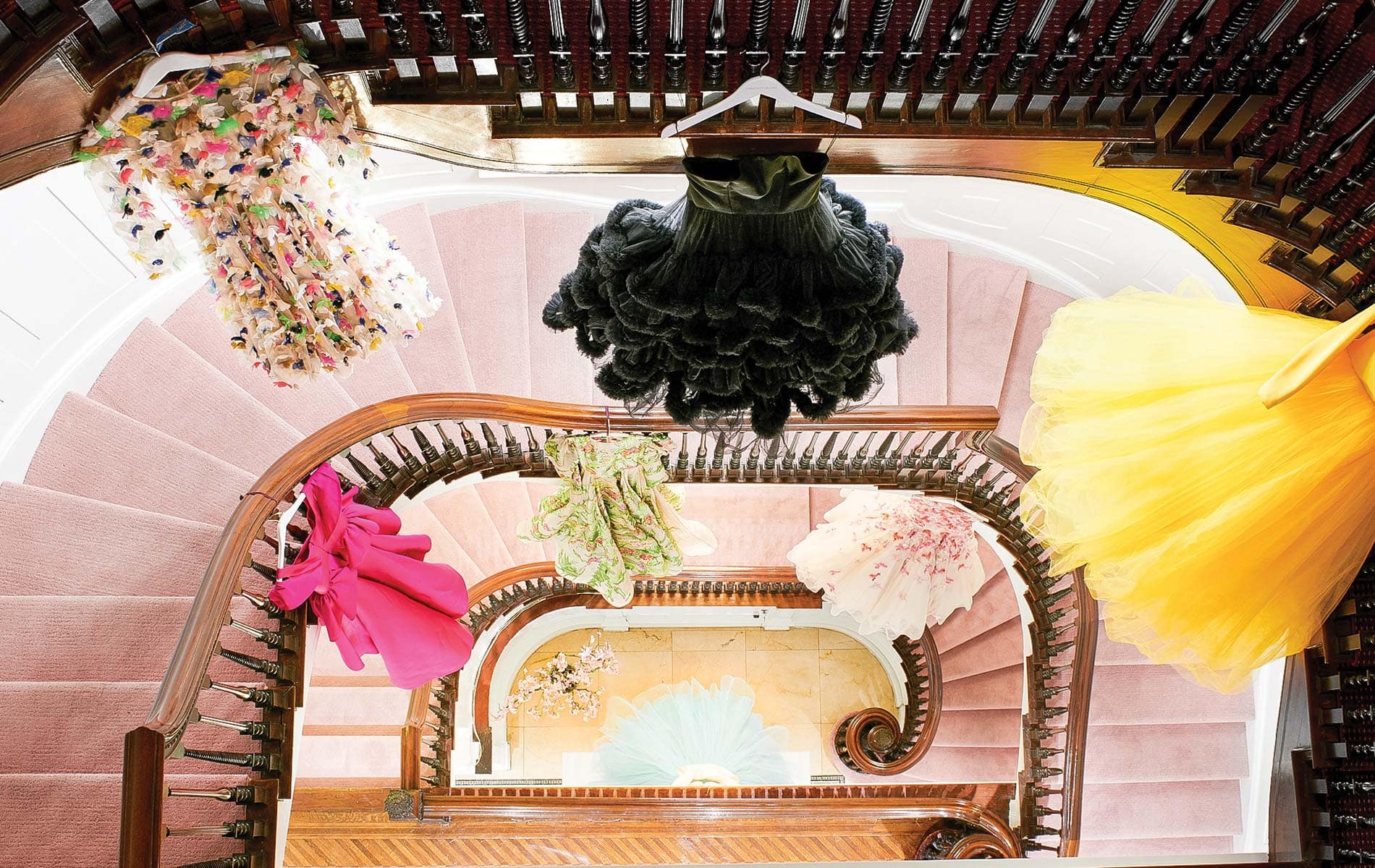
vie-magazine-the-curated-hero-min
A demure blush-pink carpet leads patrons from the front doors up the atelier’s curving stairwell to a second retail level, Siriano’s creative studio, and, eventually, a rooftop restaurant curated by actress Alicia Silverstone. | Photo by William Waldron
If the Walls Could Talk
By Melanie A. Cissone
There’s a new kid on the block. The Fifty-Fourth Street block west of Fifth Avenue—a location once reserved for early twentieth-century millionaires of the Rockefeller ilk—has welcomed fashion designer Christian Siriano and his multifaceted boutique, The Curated, to the area. The new concept store took up residence at 5 West Fifty-Fourth Street, a beautiful and storied limestone townhome, on April 17.
A fierce and freewheeling young designer—a man who shoots for the moon—Siriano has most certainly landed on a star, literally. Located just steps from tony Fifth Avenue, The Curated is housed in the Starr residence, the former home of distinguished neurologist Dr. Moses Allen Starr. An authority on the brain, the reputable and well-published Starr was a professor of neurology at Columbia University and served as president of both the New York Neurological Society and the American Neurological Association.
Saint Luke’s Hospital, which fronted Fifth Avenue from Fifty-Fourth to Fifty-Fifth Streets, moved uptown in 1896, and its massive edifice was demolished, making available some of the city’s finest lots. At a time when few buildings existed north of Madison Square, and with Starr’s impending wedding on June 7, 1898, to social registrant Alice Dunning, the doctor bought the lot and commissioned architect Robert H. Robertson to design a home. The couple moved in a year later.
- Designer Christian Siriano | Photo by William Waldron
- One step into The Curated will make shoppers feel as though they’ve left the bustling city and entered a serene, impeccably designed home where everything happens to be for sale. | Photo by Sara Kerens
- Photo by Sara Kerens
The Starr residence is described in the AIA Guide to New York City (2010) as “a modest town house (by Fifth Avenue Swath standards) with gracious fluted Ionic pilasters flanking its entry.” Compared to the neighboring 1900 McKim, Mead & White–designed University Club, which is described in the same reference guide as “a Florentine super-palazzo beyond the Medicis’ wildest dreams,” the Starr mansion is indeed modest but genuinely elegant.
In an extensive remodel of the seven-story landmarked physician’s residence, Christian Siriano brightened the serious mood of the interiors by painting the dark wood paneling white. With the beautiful sweeping staircase carpeted in ballerina pink, the hand-picked retro light fixtures neatly hung, and the furniture placed ideally for intimate conversation, Siriano coaxes this grand dame of a home into the twenty-first century while letting her keep her endearing stately charm.
Siriano says, “I wanted customers to feel like they are in a home, that they are dressing in a beautiful closet.” Fine art adorns the walls, a milliner’s tasteful headwear sits atop mannequins, and jewelry and accessories are on display; there is a wonderland of offerings at The Curated. It was a unique opportunity for Siriano to house a store and an atelier in one townhome. He adds, “I get to show the world all the things I love.”
Siriano says, “I wanted customers to feel like they are in a home, that they are dressing in a beautiful closet.”
Veteran NYC broker Anita Grossberg led the charge in finding 5 West Fifty-Fourth Street for the designer. Siriano recalls, “I was looking for a new place when Anita cooed, ‘Let’s look at something different.’” And something different is exactly what she delivered when Siriano saw the manse for the first time. In more ways than one, it seemed the designer was meant to create in that space; it turned out that the wife of the building’s owner was both a fan and customer.
The stunning nineteenth-century parquet and herringbone wood floors, the grand crown moldings, and the massive marble fireplace now serve as the backdrop for the couturier’s collections. Brightly colored gowns hang against white walls, and hand-chosen furniture and other displays showcase Siriano’s talents as a fashion designer, an interior decorator, and a curator of brands that complement his aesthetic, all celebrated alongside the unobtrusive grandeur of the building.
The Curated is a feast for the senses. Currently featured at the boutique are Betto García’s hats and accessories, jewelry by Irene Lummertz and Stephanie Kantis, soaps and lotions by Tangent, and fine art by Ewa Budka and Rebecca Russo. By summer, customers will enjoy Siriano’s “psychedelic greenhouse” collection while noshing at Joye & Rose, an espresso bar and café. Far from clueless about what’s trending, a yet-to-be-named vegetarian restaurant curated by actress and animal rights activist Alicia Silverstone is anticipated on the rooftop by year’s end.
Siriano recalls, “I was looking for a new place when Anita cooed, ‘Let’s look at something different.’”
Within a few years of the townhome’s 1899 completion, the north side of the street was populated by the families of business moguls, attorneys, publishers, and politicians, who had constructed neo-Renaissance, neo-Baroque, or Beaux-Arts mansions of their own. Neighbors included investment bankers Philip Lehman (whose father had founded the now-defunct Lehman Brothers), J. P. Morgan’s cousin and business partner James Junius Goodwin, and financier and philanthropist John D. Rockefeller, Jr.
By 1926, William Randolph Hearst had built the Warwick Hotel, a residential tower at 65 West Fifty-Fourth Street. The top floor belonged to actress Marion Davies, Hearst’s mistress. At one end of the fashionable block, where the Starr mansion is located, was the landed gentry. At the other end of the block, the Warwick held court for Broadway stage actors, Hollywood movie stars, musicians, and other celebrities of the 1920s and ’30s.
Starr’s wife lived in the house he built for her for another ten years after his death in 1932. When Alice Dunning Starr died in 1942, the next-door neighbor’s son, Robert Lehman, purchased it. Lehman donated the use of the house to the US Government as a rest home for returning World War II veterans and named it Freedom House. Toward the end of the war, the Victory Clothing Collection for Overseas Relief, an initiative to collect and distribute garments to war-torn Europe and Asia, called Freedom House its home. President Harry S. Truman said in 1946, “This winter, more than three hundred million war victims throughout the world are paying the cost of victory in poverty, disease, cold, and hunger. I therefore urge every American to heed the appeal of the Victory Clothing Collection for Overseas Relief. The spare garments contributed by Americans last spring helped clothe twenty-five million men, women, and children in Europe, China, and the Philippines, and have made possible the start of their rehabilitation this winter.”
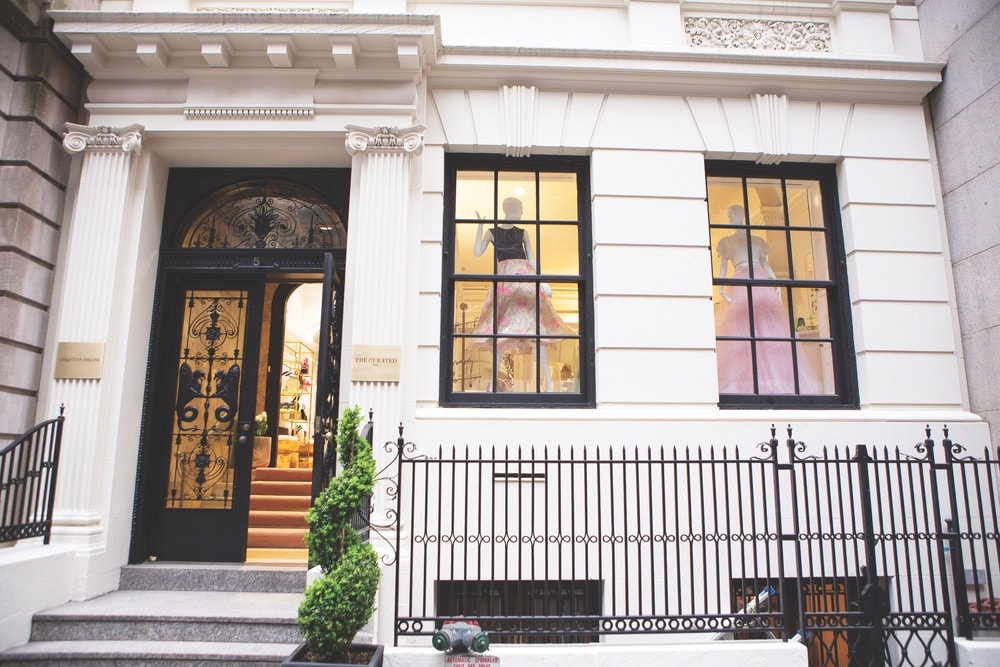
The pristine limestone facade of the building once housed the private residence of Dr. Moses Allen Starr, the Victory Clothing Collection for Overseas Relief, the headquarters of Fabergé, and other distinguished occupants. | Photo by Sara Kerens
In 1948, 5 West Fifty-Fourth Street was sold to Fabergé Inc., the cosmetics and toiletries giant founded by Sam Rubin. Fabergé hit its stride in the early 1960s when George Barrie bought the company, made the townhome its headquarters (calling it Fabergé House), and began creating legendary celebrity-endorsed ad campaigns. Remember Brut by Fabergé? Or Babe? Silhouette, Siriano’s signature fragrance, would have fit right in with them.
Fabergé hired actor Cary Grant in 1968 as one of its first “creative consultants,” something akin to a brand ambassador in today’s lingo. Grant was offered $15,000 a year, stock options, a seat on the board of directors, and something special to sweeten the deal—Fabergé rented Marion Davies’s old apartment in the Warwick Hotel for him. The famously handsome actor took the deal, moved out of the Plaza Hotel, stayed on for twelve years, and kept an office at Fabergé House. Grant also inaugurated the annual Straw Hat Awards, an informal ceremony to recognize summer stock theatre and actors, the first of which was held at Fabergé House.
Greek shipping magnate John S. Latsis bought the house in 1974 and restored it to its original glory. Latsis named 5 West Fifty-Fourth Street Petrola House, a name that stuck until The Curated arrived this year.
- In addition to beautiful clothing and accessories by Christian Siriano, The Curated currently carries luxury brands such as Universal Standard, Stephanie Kantis, Irene Lummertz, Objectifs, Rebecca Russo, Betto García, Tangent, Ewa Budka (whose art is pictured here), and more. | Photo by Sara Kerens
- A chic seating area flanks the second-floor fireplace to create an intimate waiting space perfect for striking up a conversation or admiring Siriano’s book Dresses to Dream About. | Photo by William Waldron
Is it kismet that Christian Siriano would occupy the Starr residence? While the designer was busy building a business in the last ten years, the building was vacant. It’s almost as though 5 West Fifty-Fourth Street was waiting for Siriano and no one else. His glamorous clothing seems to have been waiting to hang right where it is—on display in the beautiful setting that the millionaire’s mansion affords. It belongs there. Seeing his designs in The Curated is like admiring artwork hanging in a gallery.
In 2008, at age twenty-two, Siriano became (and remains) the youngest winner of the popular series Project Runway. Recently he celebrated ten years in business by publishing his second book, Dresses to Dream About. Given his young age, Siriano’s business acumen is astonishingly equal to his design talent. He says, “I’m always interested in that side of things.” He credits licensing deals—like the one he has with Payless Shoes—with his having learned a lot about the business side of fashion. “I love to see what’s moving or whether I’ve priced a dress well. My mother was a teacher who pushed my sister and me to strive for more. She would say, ‘I can afford to buy you this, but if you want the other, you’ll have to earn the money yourself to get it.’”
- The Curated, a new high-end atelier by New York fashion designer Christian Siriano, opened April 17, 2018, on West Fifty-Fourth Street in Manhattan. | Photo by William Waldron
- Joye & Rose, The Curated’s patio café, is a perfect summertime spot offering espresso, tea, sandwiches, and pastries. | Photo by Sara Kerens
Magnanimous (with a dash of Energizer bunny) is the only way to think of Siriano. Not only did he dress seventeen women for the Academy Awards in March, but he has also been dressing women (and men) of all shapes, sizes, and skin tones—both celebrities and the models who walk his runways—for the past ten years. The most notable was SNL comedienne Leslie Jones who famously tweeted that no designer would dress her for her Ghostbusters film premiere. Emoji hands representing “Hey, over here” was Siriano’s response to her. A fan and a client now, Jones was a runway-show virgin when she sat flanked by Siriano’s musician husband, Brad Walsh, and actress Jackie Cruz in the front row at his Spring 2018 New York Fashion Week show. She could be seen whooping and hollering like she was at a basketball game, bringing fun and joy to an event that would typically be considered somewhat sedate.
Never at a loss for ideas, Siriano says, “The most random things can be inspiring to me.” Almost immediately upon finishing a collection, the designer is “on to the next thing.” Perhaps the people who walked the halls of 5 West Fifty-Fourth Street before him—or the building itself—will be some of his new muses.
Perhaps the people who walked the halls of 5 West Fifty-Fourth Street before him—or the building itself—will be some of his new muses.
“Confused, without a clear conception,” was how author Russell Sturgis described the Starr residence in “The Art Gallery of the New York Streets,” an article published in The Architectural Record in 1900. Nothing could be further from the truth in the building’s iteration today. From its inception, Siriano has had a razor-sharp focus on The Curated’s intimate experiential direction—very necessary in the present-day retail environment. Add to it the designer’s joie de vivre, the creativity that flows from his old-school atelier, the boutique filled with exquisite fashion, accessories, art, and decor, and this special place will be a fountain from whence new stories will spring and assimilate into the 119-year-old walls.
When he opened The Curated’s doors in April, Siriano invited the world into his universe. It is most certainly worth a visit.
— V —
New York City transplant to the Emerald Coast Melanie Cissone has been a freelance writer for twenty years. A patron of the arts, she is inspired by beautiful architecture and design and loves learning about people’s backgrounds, especially over a dry Italian red wine.
Share This Story!
KEEP UP WITH THE LATEST STORIES FROM VIE



